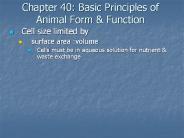Coelenterates PowerPoint PPT Presentations
All Time
Recommended
... hydroids and jellyfish. Polyp. medusa ... and a giant clam. Cubozoa, the amazing box jellies with complex eyes and potent toxins; ... Life Cycle of a Jellyfish ...
| PowerPoint PPT presentation | free to view
A system of nerve cells called a Nerve net. Special nerve cells sting their prey to paralyze them ... Examples: coral anemone, hydra, jellyfish. This is an anemone ...
| PowerPoint PPT presentation | free to view
"Copy Link : gooread.fileunlimited.club/pwjul24/0849344891 Handbook of Clinical Toxicology of Animal Venoms and Poisons 1st Edition The Handbook of Clinical Toxicology of Animal Venoms is the first concise, one-volume book devoted to this important subject. The editors are internationally recognized authorities in the biology and clinical aspects of venomous and poisonous animals, and the chapter authors are world leaders in their respective fields of toxicology.All aspects of the topic are covered including information on the biology and taxonomy of poisonous animals, their venom or poison, diagnosis, and general treatment principles and specific treatment. The most up-to-date list of available antivenoms is provided. Coverage of venomous and poisonous animals is comprehensive, with thorough discussions on shellfish poisoning, ciguatera, fugu, coelenterates, stingrays, venous fish, blue-ringed octopus, sea-snakes, scorpions, sp"
| PowerPoint PPT presentation | free to download
How does oxygen enter an flatworm's body? Answer. It diffuses into it. Card 18. What do flatworms have that make them more advanced than coelenterates? Answer ...
| PowerPoint PPT presentation | free to view
unlike sponges and coelenterates because they have a definite head and tail ... endoderm / mesoderm / ectoderm. Organized cells/ tissues / organs / organ systems but. ...
| PowerPoint PPT presentation | free to view
Phylum Cnidaria The Stinging Celled animals Kingdom Animalia Approx. 11,000 species * * * * * * * * * * * * * * * * * * * * * * Cnidarian Habitat All live in ...
| PowerPoint PPT presentation | free to view
Uses of Cilia and Flagella. Locomotive appendages. Produce from certain cells. Cilia ... Cilia and Flagella. The difference between cilia and flagella are the ...
| PowerPoint PPT presentation | free to view
Almost all animals fall into one of two groups. ... sorts of habitats from the bottom of the ocean to the inside of other animals. ...
| PowerPoint PPT presentation | free to view
INTRODUCTION TO MARINE ... to jellyfish Feed with stinging tentacles Live attached to the sea floor in large colonies Construct hard calcium carbonate structures ...
| PowerPoint PPT presentation | free to download
Sea Anemone. Page 323 Figure 9. PHYSICAL CHARACTERISTICS. 1. Where do they live? ... examples: sea anemone and coral. Medusa. example: jellyfish ...
| PowerPoint PPT presentation | free to view
Benthic Fauna Benthic Fauna Extremely diverse group of organisms Many different groups, difficult to generalize about patterns Distribution and Abundance Limited by ...
| PowerPoint PPT presentation | free to download
Diversity of Organisms and Classification Classification of Organisms Species The smallest group of organisms classified which can interbreed with each other to ...
| PowerPoint PPT presentation | free to download
This Presentation described the preservation method in easy words..
| PowerPoint PPT presentation | free to download
What are the three shapes of bacteria? Kingdom Protista('Protists' ... Kingdom Protista. no cell wall or chlorophyll. internal digestion. no locomotion (some) ...
| PowerPoint PPT presentation | free to download
Adaptive Geometry of a Selfish Herd ... benefits of behaviors tit for tat strategy + forgiveness can ... Nonassociated 32.1 55 89 Feeding ...
| PowerPoint PPT presentation | free to download
Strange but true Sea Cucumber Echinoderms (like starfish, sea urchins, sand dollars) Radially symmetrical Have a water-vascular system that functions as hydraulic ...
| PowerPoint PPT presentation | free to view
The largest jellyfish is the Arctic Giant Jellyfish: it can have a diameter over ... The most venomous jellyfish is the Australian Sea Wasp; death can occur within 1 ...
| PowerPoint PPT presentation | free to view
Includes: diatoms, dinoflagellates, larvae, jellyfish, bacteria. ... Megaplankton ( 2,000 m) includes jellyfish, ctenophores, Mola mola ...
| PowerPoint PPT presentation | free to download
The Animal Kingdom Classification and Organization Dr. Jim Whitfield
| PowerPoint PPT presentation | free to view
Typical to the waters of Bermuda are the Turtle grass and the Manatee grass. ... This is a brown algae, phaeophyta. ... Chlorophyta: Mermaids Wine Glasses ...
| PowerPoint PPT presentation | free to view
Diversity of Modern Life Kingdom Monera ( Monerans ) Smallest and simplest lifeforms Unicellular (one-celled) no nucleus Bacteria and cyanobacteria Bacteria Three ...
| PowerPoint PPT presentation | free to view
Title: Invertebrates Author: owner Last modified by: Amanda Pittman Created Date: 1/26/2006 5:37:29 PM Document presentation format: On-screen Show (4:3)
| PowerPoint PPT presentation | free to download
Bioinformatics CSM17 Week 8: Simulations (1) Soft Computing: Genetic Algorithms Evolutionary Computation Neural Networks JYC: CSM17
| PowerPoint PPT presentation | free to view
Single-celled, living in chains or clusters. Subdivided into bacteria (consumers) and Cyanobacteria ... http://www.gotpetsonline.com, www.seaworld.com. Birds ...
| PowerPoint PPT presentation | free to view
Dog Bites and Rabies (2 of 2) Rabies- an acute viral infection to the central nervous system Can only be treated with a series of vaccine injections.
| PowerPoint PPT presentation | free to view
Tadpoles, the young stage of amphibians, are fish-like and live in water. ... Amphibians. They have two pairs of limbs with five digits each in the adult stage ...
| PowerPoint PPT presentation | free to download
... Table of Contents Eukaryotes Prokaryotes Kingdom Animalia Multicellular / Eukaryotic Sexual reproduction Life cycle: ... Sea Urchin Anatomy mouth ...
| PowerPoint PPT presentation | free to download
TSW be able to recognize and give examples of the three types of symmetry found in animals. ... between the following body parts ... of animals that falls ...
| PowerPoint PPT presentation | free to download
Title: Bites & stings Author: dw Last modified by: Carla Porter Created Date: 4/22/1996 3:20:24 PM Document presentation format: On-screen Show Other titles
| PowerPoint PPT presentation | free to view
Exotic Species Threat to the Mississippi River Basin
| PowerPoint PPT presentation | free to view
reproduction in seed plants ch.24 complete (perfect) flowers complete flowers have 4 typical flower parts: stamens, pistils, sepals, and petals.
| PowerPoint PPT presentation | free to download
Amphibians and Reptiles
| PowerPoint PPT presentation | free to view
They are useful as chemical defense substances to the organisms which produce ... Neurotoxic shellfish poisoning. Toxic aerosols produce asthma like symptoms. ...
| PowerPoint PPT presentation | free to view
The Dimensions. Utnapishtim's Ark. Epic of Gilgamesh. To build ... covenant with you, and you. will enter the ark - you and. your sons and your wife and ...
| PowerPoint PPT presentation | free to view
Drug Discovery from Marine Sources Prof. Dr. Basvaraj K. Nanjwade M. Pharm., Ph. D Department of Pharmaceutics KLE University College of Pharmacy
| PowerPoint PPT presentation | free to view
... poverty, nutrition, poor health education 26,201 9. Liver Disease psychological stress, poverty, nutrition 30,796 8. Suicide nutrition, poverty, ...
| PowerPoint PPT presentation | free to download
Chapter 40: Basic Principles of Animal Form & Function Cell size limited by surface area :volume Cells must be in aqueous solution for nutrient & waste exchange
| PowerPoint PPT presentation | free to download
Vertebrate Biology Lecture Notes The Phylum Chordata Vertebrates belong to the Phylum Chordata - these are animals that, at one stage or another of their life ...
| PowerPoint PPT presentation | free to view
... The anemone fish lives among the forest of tentacles of an anemone and is ... The anemone treats the fish as part of itself and does not sting it. Predator ...
| PowerPoint PPT presentation | free to view
Definition of Life & Classifying it The properties or qualities that distinguishes living organisms from dead organisms and inanimate matter are the living functions.
| PowerPoint PPT presentation | free to view
Humans have about 100 billion neurons in their brain alone! ... Fluid and tissue also insulate the brain and spinal cord. The Brain ...
| PowerPoint PPT presentation | free to view
Chp 5 Nutrition, Feeding, and Digestion Nutrition See Chp 2 on Chemistry to review the various components of the body (proteins, carbohydrates, lipids) Animals needs ...
| PowerPoint PPT presentation | free to view
... stage or another of their life cycle possess the following three characteristics: ... Pisces. Superclass. Tetrapoda. Anamniotes. Amniotes ...
| PowerPoint PPT presentation | free to view
Synthesis of methyl ketone 10. Synthesis of macrocycle 12 ... Synthesis of ketone 16. Wolff rearrangement. Synthesis of Dolabellatrienone 2. Conclusion ...
| PowerPoint PPT presentation | free to view
Invertebrates (Ch.33) Sponges,;Cnidarians; Molluscs, Annelids; Nematodes; Arthropods ... most intelligent invertebrates. Squids are speedy carnivores. with ...
| PowerPoint PPT presentation | free to view
Mutualism is an interaction between two species in which both participants benefit ... must produce nectar just sweet enough to attract pollinator, but no sweeter ...
| PowerPoint PPT presentation | free to view
Animals are multicellular, heterotrophic eukaryotes with tissues ... Fig. 26.22 (we have used this several times before) ...
| PowerPoint PPT presentation | free to view
Read and take note of important material relative to the learning objectives below. ... Ameba, paramecium. Want to learn more about protista ...
| PowerPoint PPT presentation | free to view
to a host of questions connected with animal achievements. Additional Purpose ... Trivia. Physical Format. Book Form. Out of Print. Special Features. Illustrations ...
| PowerPoint PPT presentation | free to view
The science of classifying organisms into their levels is called taxonomy. ... or backbone, running the length of the body; invertebrates do not.
| PowerPoint PPT presentation | free to download
digestive system ...
| PowerPoint PPT presentation | free to download
Life in General Living matter is organized into complex structures based on organic molecules. They have cells. Homeostasis is maintained by Living organisms.
| PowerPoint PPT presentation | free to download
The Fossil Record CHAPTER 4 Fossil Preservation Preservation as a fossil usually requires: Preservable parts. Hard parts (bones, shells, teeth, wood) have a much ...
| PowerPoint PPT presentation | free to view
Objectives (1 of 5) Identify the signs and symptoms of the acute abdomen and the necessity for ... Appendicitis. Perforated gastric ulcer. Cholecystitis ...
| PowerPoint PPT presentation | free to view
We are vertebrates and have a skeleton to keep us upright and to help us to move ... scales and fins located in the. thorax, stomach, back and. tail. hake. salmon ...
| PowerPoint PPT presentation | free to view
























































